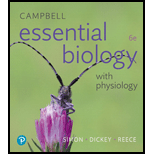
a.
To determine: Which part of the plant is the tomato.
Concept introduction: The plant body consists of a root system and shoots system. The roots are formed under the soil, and the upper part forms a shoot that gives rise to a leaf, stem, flower, and fruit. The root anchors the plant to the soil and transports minerals and water and stores food. The leaves are the primary sites of photosynthesis and help in exchange of gases with the atmosphere and to dissipate the heat.
b.
To determine: Which part of the plant is the apple.
Concept introduction: The plant body consists of a root system and shoot system. The roots are formed under the soil, and the upper part forms a shoot that gives rise to a leaf, stem, flower, and fruit. The root anchors the plant to the soil and transports minerals and water and stores food. The leaves are the primary sites of photosynthesis and help in exchange of gases with the atmosphere and to dissipate the heat.
c.
To determine: Which part of the plant is the spinach.
Concept introduction: The plant body consists of a root system and shoot system. The roots are formed under the soil, and the upper part forms a shoot that gives rise to a leaf, stem, flower, and fruit. The root anchors the plant to the soil and transports minerals and water and stores food. The leaves are the primary sites of photosynthesis and help in exchange of gases with the atmosphere and to dissipate the heat.
d.
To determine: Which part of the plant is the sweet potato.
Concept introduction: The plant body consists of a root system and shoot system. The roots are formed under the soil, and the upper part forms a shoot that gives rise to a leaf, stem, flower, and fruit. The root anchors the plant to the soil and transports minerals and water and stores food. The leaves are the primary sites of photosynthesis and help in exchange of gases with the atmosphere and to dissipate the heat.
e.
To determine: Which part of the plant is the black bean.
Concept introduction: The plant body consists of a root system and shoot system. The roots are formed under the soil, and the upper part forms a shoot that gives rise to a leaf, stem, flower, and fruit. The root anchors the plant to the soil and transports minerals and water and stores food. The leaves are the primary sites of photosynthesis and help in exchange of gases with the atmosphere and to dissipate the heat.
Want to see the full answer?
Check out a sample textbook solution
Chapter 28 Solutions
Campbell Essential Biology with Physiology (6th Edition)
 Human Anatomy & Physiology (11th Edition)BiologyISBN:9780134580999Author:Elaine N. Marieb, Katja N. HoehnPublisher:PEARSON
Human Anatomy & Physiology (11th Edition)BiologyISBN:9780134580999Author:Elaine N. Marieb, Katja N. HoehnPublisher:PEARSON Biology 2eBiologyISBN:9781947172517Author:Matthew Douglas, Jung Choi, Mary Ann ClarkPublisher:OpenStax
Biology 2eBiologyISBN:9781947172517Author:Matthew Douglas, Jung Choi, Mary Ann ClarkPublisher:OpenStax Anatomy & PhysiologyBiologyISBN:9781259398629Author:McKinley, Michael P., O'loughlin, Valerie Dean, Bidle, Theresa StouterPublisher:Mcgraw Hill Education,
Anatomy & PhysiologyBiologyISBN:9781259398629Author:McKinley, Michael P., O'loughlin, Valerie Dean, Bidle, Theresa StouterPublisher:Mcgraw Hill Education, Molecular Biology of the Cell (Sixth Edition)BiologyISBN:9780815344322Author:Bruce Alberts, Alexander D. Johnson, Julian Lewis, David Morgan, Martin Raff, Keith Roberts, Peter WalterPublisher:W. W. Norton & Company
Molecular Biology of the Cell (Sixth Edition)BiologyISBN:9780815344322Author:Bruce Alberts, Alexander D. Johnson, Julian Lewis, David Morgan, Martin Raff, Keith Roberts, Peter WalterPublisher:W. W. Norton & Company Laboratory Manual For Human Anatomy & PhysiologyBiologyISBN:9781260159363Author:Martin, Terry R., Prentice-craver, CynthiaPublisher:McGraw-Hill Publishing Co.
Laboratory Manual For Human Anatomy & PhysiologyBiologyISBN:9781260159363Author:Martin, Terry R., Prentice-craver, CynthiaPublisher:McGraw-Hill Publishing Co. Inquiry Into Life (16th Edition)BiologyISBN:9781260231700Author:Sylvia S. Mader, Michael WindelspechtPublisher:McGraw Hill Education
Inquiry Into Life (16th Edition)BiologyISBN:9781260231700Author:Sylvia S. Mader, Michael WindelspechtPublisher:McGraw Hill Education





